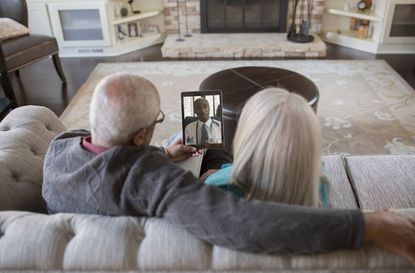What Retirees Must Know About Telehealth
The coronavirus has elevated the benefits and potential savings of telehealth like nothing before.

When the deadly coronavirus began tearing through the country this past spring, tens of thousands of people with the virus’s signature symptoms — high fever, dry cough, extreme tiredness and labored breathing — overwhelmed many hospitals. Healthier patients who wanted testing or treatment for other illnesses had to be kept out of doctors’ offices and emergency rooms to stop the virus from spreading.
The health care industry needed a solution fast, and technology provided one. Using video chat services like Zoom and Skype, smartphones or ordinary telephones, patients could still get medical care while practicing social distancing.
Harnessing new technology to connect patients with doctors is hardly a new idea, but the coronavirus has elevated the benefits and potential savings of telehealth like nothing before. The ubiquity of smartphones, tablets and other technologies that allow doctors and patients to talk and share medical images in real time at any hour of the day or night has made telehealth a practical alternative to many — but not all — office visits.

Sign up for Kiplinger’s Free E-Newsletters
Profit and prosper with the best of expert advice on investing, taxes, retirement, personal finance and more - straight to your e-mail.
Profit and prosper with the best of expert advice - straight to your e-mail.
What Is Telehealth?
Telehealth is a broad term that encompasses multiple ways — video conferencing, smartphone apps and other communication tools — caregivers can diagnose, treat and monitor patients without having to be in the same location.Telehealth encompasses several distinct fields:
- Live telemedicine uses a live audio and video link to enable doctors or other medical professionals to talk with patients, conduct limited examinations, order tests and sometimes diagnose and even treat ailments remotely.
- Store-and-forward telemedicine is an asynchronous audio and video link that records descriptions, images and patient data at a time convenient for the patient and transmits it later at a time convenient for a care provider, often a specialist.
- Remote patient monitoring uses connected electronic devices to regularly or continuously record health and medical data in one location for review by a provider in another location, usually at a different time.
- Mobile health, or mHealth, is health care and public health information provided through mobile devices, such as a smartphone or tablet, to targeted audiences. The public health announcements may be general educational information, targeted texts or notifications about disease outbreaks such as COVID-19.
Insurance Coverage for Telehealth
Although many private health insurers have offered telehealth for several years, Medicare has lagged behind covering the service. Then, in March 2020, with the virus spreading rapidly, Washington gave telehealth a shot in the arm by bending long-standing Medicare reimbursement rules for physicians and other health care professionals who use technology to remotely examine and treat Medicare patients at home.
Meanwhile, big health insurers reduced or waived fees for telehealth. For 90 days at the height of the pandemic, Anthem, for example, waived copays and deductibles for all telehealth services, including those for mental health, substance use disorders and treatment or testing for the virus. UnitedHealthcare extended its waiver of some coronavirus-related telehealth fees to include out-of-network doctors.
“We are making every effort to protect the health of our members by keeping them safe in their homes while still enabling them to get the care they need,” says Dirk McMahon, CEO of UnitedHealthcare, which has been covering telehealth services for employer and individual plans since 2016 and self-insured employers since 2015.
Slow Adoption of the Technology
Telehealth has yet to catch on with many older patients, who are more likely to visit their doctors in person. A Harris Poll conducted for the telemedicine company American Well found that more than half of 400 Americans over the age of 65 were willing to try telehealth, but only about 1% to 2% actually used it. Among older adults who have used telehealth, 84% said they did so mostly for the low-tech task of renewing prescriptions.
Doctors weren’t much better. Of 800 emergency room doctors who participated in a parallel survey, 89% said they would use telehealth technology, but only 11% actually did. Similarly, 83% of infectious-disease specialists in the survey expressed a willingness to try telehealth, but only 17% said they had done so.
Convenient and Quick
Telehealth advocates say those numbers will change as baby boomers pass away and tech-savvy younger generations, so-called “internet natives,” comprise a larger percentage of the patient pool. The virus may already be accelerating that shift.
At health insurer Anthem, the pandemic and fee waivers are encouraging a lot of people to give telehealth a try. Patients can access Anthem’s telehealth services in one of two ways: LiveHealth Online, which is a two-way video link to doctors, and the insurer’s Sydney Care app, which monitors the user’s health and recommends when medical help may be needed.
“We’ve been tracking utilization of all of our virtual care offerings,” says Leslie Porras, senior public relations director at Anthem. “Completed visits for LiveHealth Online are up 250% versus the norm for this time of year. Since Jan. 1, 2020, we have seen more than 175,000 downloads of the Sydney Care app.”
Something similar has happened at UnitedHealthcare, where the number of telehealth visits increased significantly during the pandemic. The insurer is still examining claims data to determine how much that increase was.
Doctors like Shannon McNamara, an emergency room physician who served as a telemedicine coach, have also embraced virtual visits. During the pandemic, she tweeted that people who were worried they might have COVID-19 or some of its symptoms should set up a video visit with a telehealth doctor.
“The great thing about (telehealth) is getting personalized medical advice,” she tweeted.
Although wait times for telehealth visits have grown since the pandemic began, it’s generally faster and more convenient for most patients to get treated by their doctors this way. Danielle Woodley, a 26-year-old digital marketer in Los Angeles, says she was introduced to telehealth before the pandemic during a trip to Arizona. Her throat was sore and speckled with white dots, suggesting a strep infection, but she was too busy to call her regular doctor in California. Instead, she used a telehealth app that her employer asked all employees to download to their smartphones.
“I love my doctor (in California), but there are so many steps to get seen,” starting with a phone tree just to get through to the voicemail box of the doctor’s scheduler, Woodley says. In contrast, the telehealth service answered her call quickly, and within minutes her prescription medicine was waiting for her at a nearby branch of a national pharmacy chain.
“I thought, ‘actually, this is not bad,’” Woodley says. “It was very convenient. The prescription arrived at the pharmacy much faster than it ever did at home.” Megan Coffman, the administrator of health policy research at the the Robert Graham Center for Policy Studies in Family Medicine and Primary Care, says the growing demand for telehealth could be matched by new doctors who are comfortable with the technology if they have more experience using it during their medical training.
“Family physicians have identified lack of training on how to use telehealth as a barrier to providing telehealth services,” she says. “If family physicians are not provided opportunities to deliver telehealth in residency, it may prevent them from offering telehealth services to their patients once in practice.”
The Benefits of Telehealth
There is evidence of telehealth-driven savings for patients with private insurance. Regence, which operates Blue Cross Blue Shield health insurance plans in the Pacific Northwest, calculated that consumers who opted for telehealth over a traditional office visit saved an average of $100 per visit in 2019.
Brian Marcotte, president of the National Business Group on Health, breaks those savings down further. He says having a doctor treat an upper respiratory infection could cost as little as $40 via a video call compared to a doctor’s office visit that would run about $100. An urgent care center’s bill would be something in the neighborhood of $150. A visit to a hospital emergency room could set you back $700, he says.
Politicians are also looking to keep telehealth pricing competitive. In 32 states, virtual visits must cost the same or less than office appointments, with three more states considering similar laws. In rural areas, where the nearest health clinic can be a three-hour drive away, telehealth offers patients the added savings of travel costs.
In fact, the original purpose of telehealth was to deliver better care at lower prices to people in rural areas, but a pilot program in Rochester, N.Y., found that urban areas also reaped similar benefits. Surveys conducted after the program ended found that 93% of patients said telehealth saved them from making expensive after-hours trips to clinics, and 86% said it enabled them to avoid going to an even more expensive emergency room. Telehealth networks also could enable people with asthma, diabetes, arthritis and other chronic illnesses to conduct routine follow-up appointments at home without having to set foot in a doctor’s office.
Some researchers counter that patients, Medicare beneficiaries and insurers won't pay less if telehealth’s convenience encourages medical practitioners to order more follow-up appointments, tests and prescriptions than they do now. So far, that doesn’t seem to be happening. From its analysis, Regence found that most telehealth visits simply replaced another care setting, and the patient’s health issue was resolved with no supplemental visit needed within seven days for the same ailment in 95% of cases.
For some doctors, the pandemic has been a wakeup call that modern health care needs revamping. “Traditional medicine has let us down,” said Dr. Joseph Pazona, a urologist in Nashville, Tenn. “We need to do radical things to improve.”
-
 It’s Tax Day: Is the Post Office Open Late?
It’s Tax Day: Is the Post Office Open Late?Tax Filing Tax Day is here and some people need to mail their federal income tax returns.
By Kelley R. Taylor Published
-
 Need to Build an Emergency Fund? Seven Steps to Get There
Need to Build an Emergency Fund? Seven Steps to Get ThereHaving a safety net can mean peace of mind on top of being able to maintain your lifestyle if a financial emergency strikes.
By Justin Stivers, Esq. Published
-
 403(b) Contribution Limits for 2024
403(b) Contribution Limits for 2024retirement plans Teachers and nonprofit workers can contribute more to a 403(b) retirement plan in 2024 than they could in 2023.
By Jackie Stewart Published
-
 SEP IRA Contribution Limits for 2024
SEP IRA Contribution Limits for 2024SEP IRA A good option for small business owners, SEP IRAs allow individual annual contributions of as much as $69,000 a year.
By Jackie Stewart Published
-
 Roth IRA Contribution Limits for 2024
Roth IRA Contribution Limits for 2024Roth IRAs Roth IRA contribution limits have gone up for 2024. Here's what you need to know.
By Jackie Stewart Published
-
 SIMPLE IRA Contribution Limits for 2024
SIMPLE IRA Contribution Limits for 2024simple IRA The maximum amount workers at small businesses can contribute to a SIMPLE IRA increased by $500 for 2024.
By Jackie Stewart Published
-
 457 Contribution Limits for 2024
457 Contribution Limits for 2024retirement plans State and local government workers can contribute more to their 457 plans in 2024 than in 2023.
By Jackie Stewart Published
-
 Roth 401(k) Contribution Limits for 2024
Roth 401(k) Contribution Limits for 2024retirement plans The Roth 401(k) contribution limit for 2024 is increasing, and workers who are 50 and older can save even more.
By Jackie Stewart Published
-
 Four Tips for Renting Out Your Home on Airbnb
Four Tips for Renting Out Your Home on Airbnbreal estate Here's what you should know before listing your home on Airbnb.
By Miriam Cross Published
-
 Five Ways to a Cheap Last-Minute Vacation
Five Ways to a Cheap Last-Minute VacationTravel Procrastinator? No matter. You can pull off a fun and memorable getaway on a moment's notice — without breaking the bank.
By Vaishali Varu Last updated